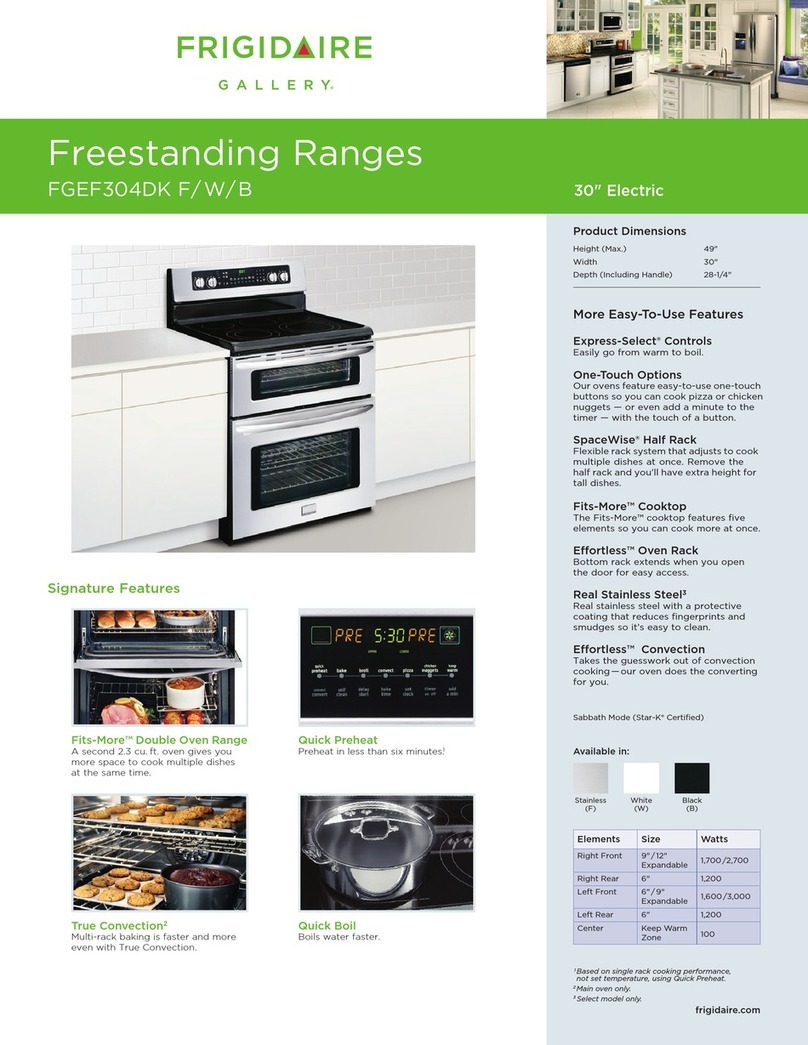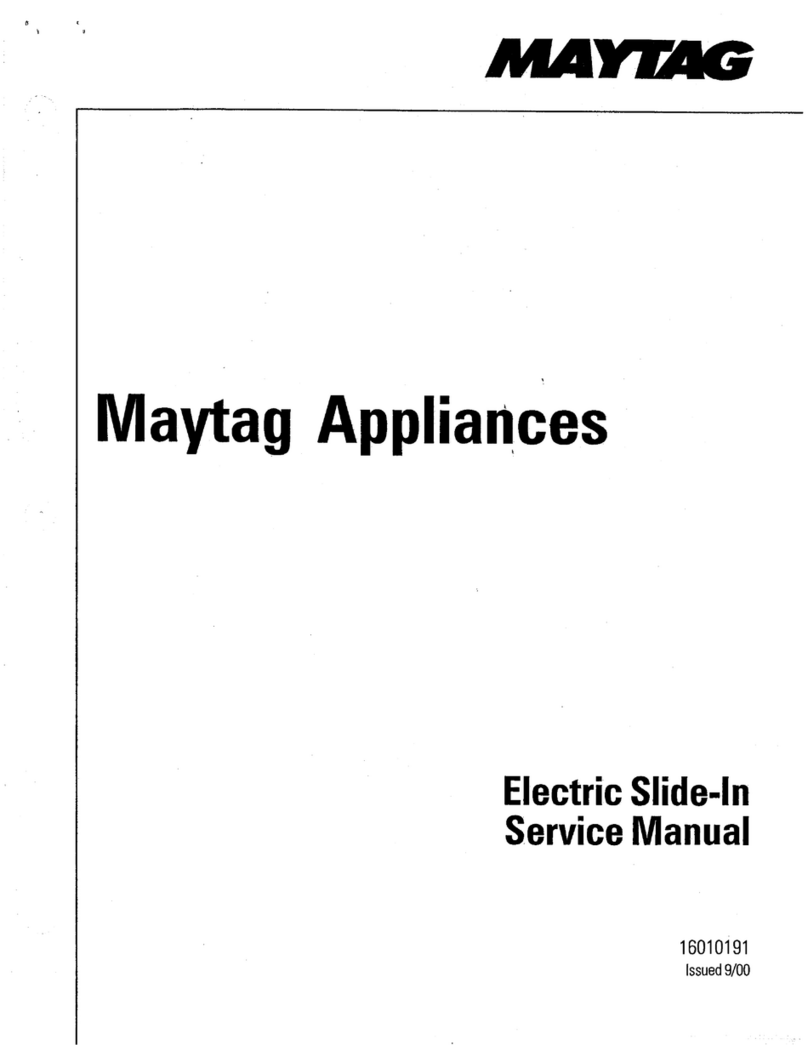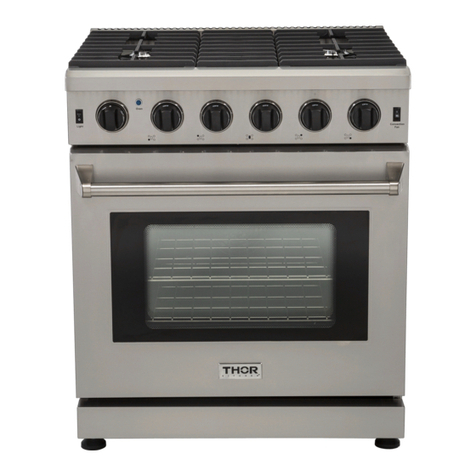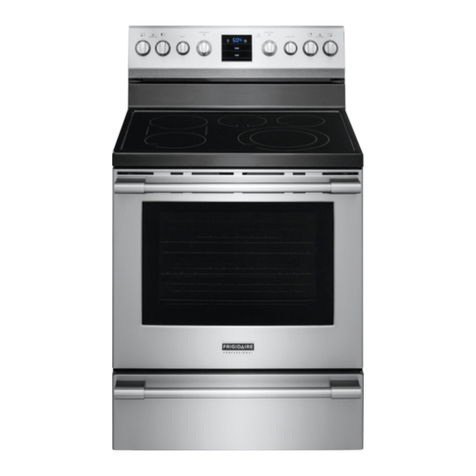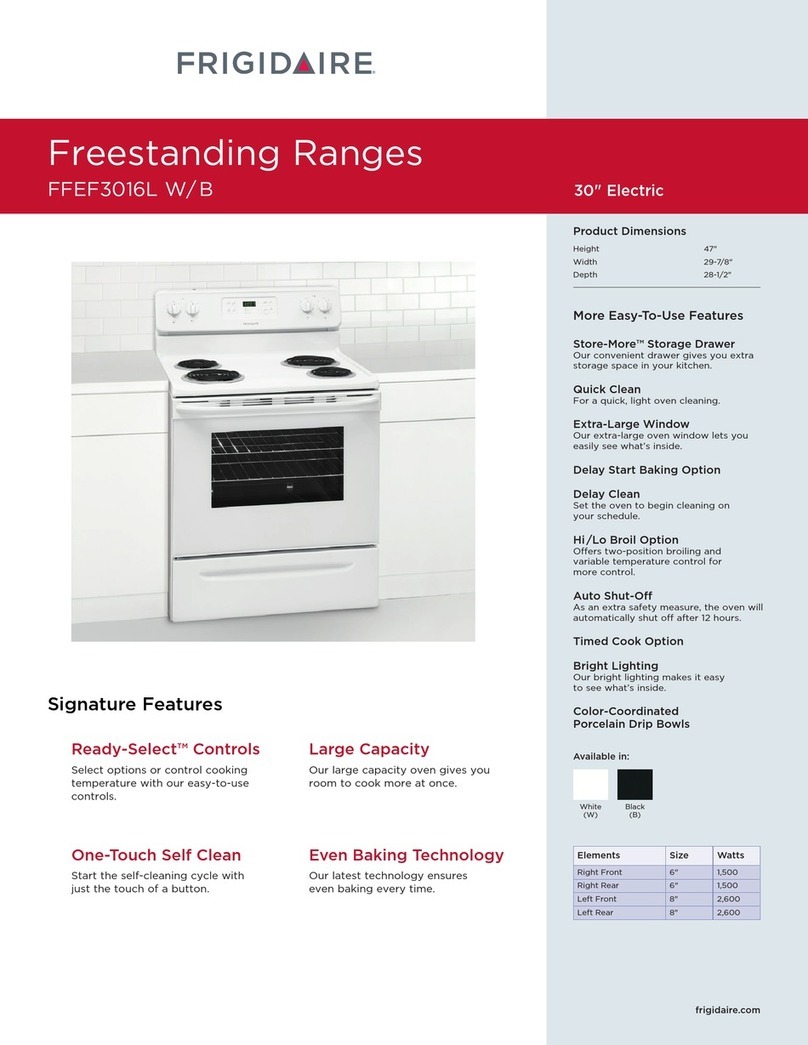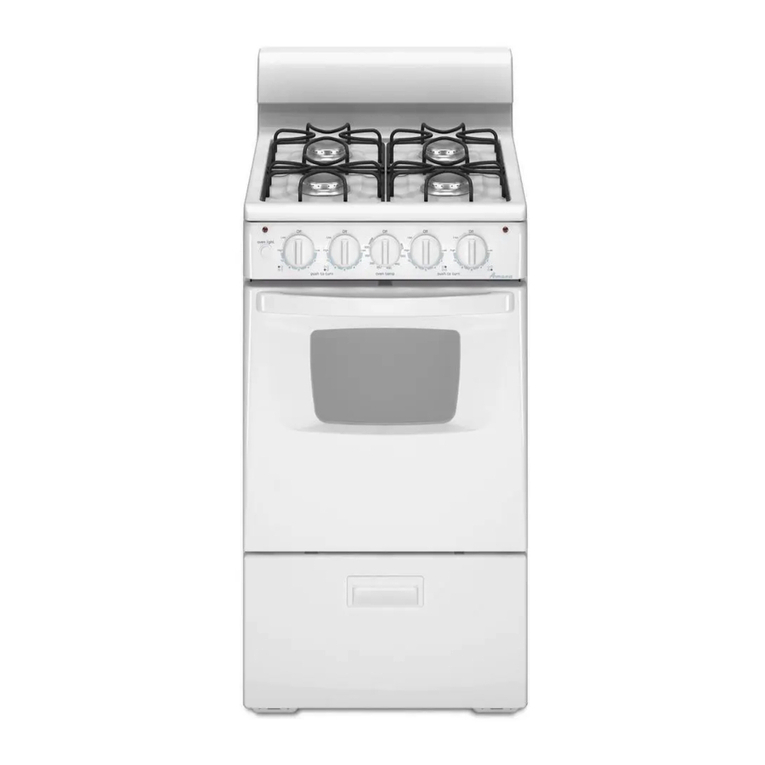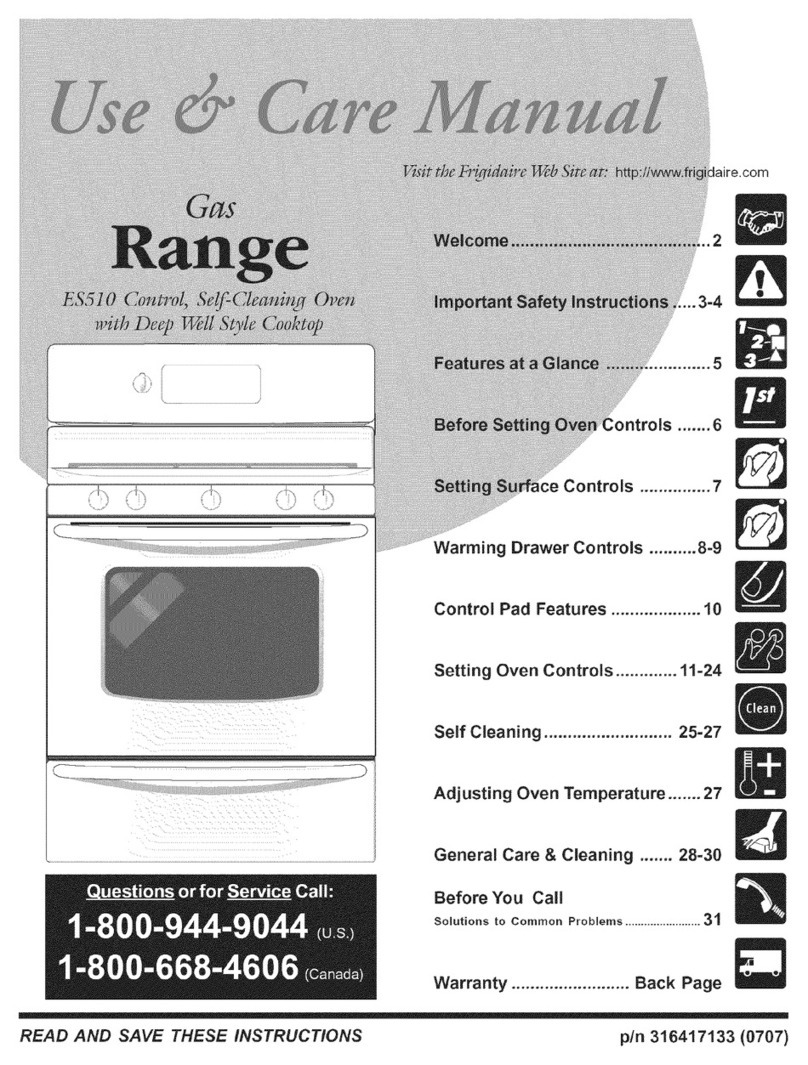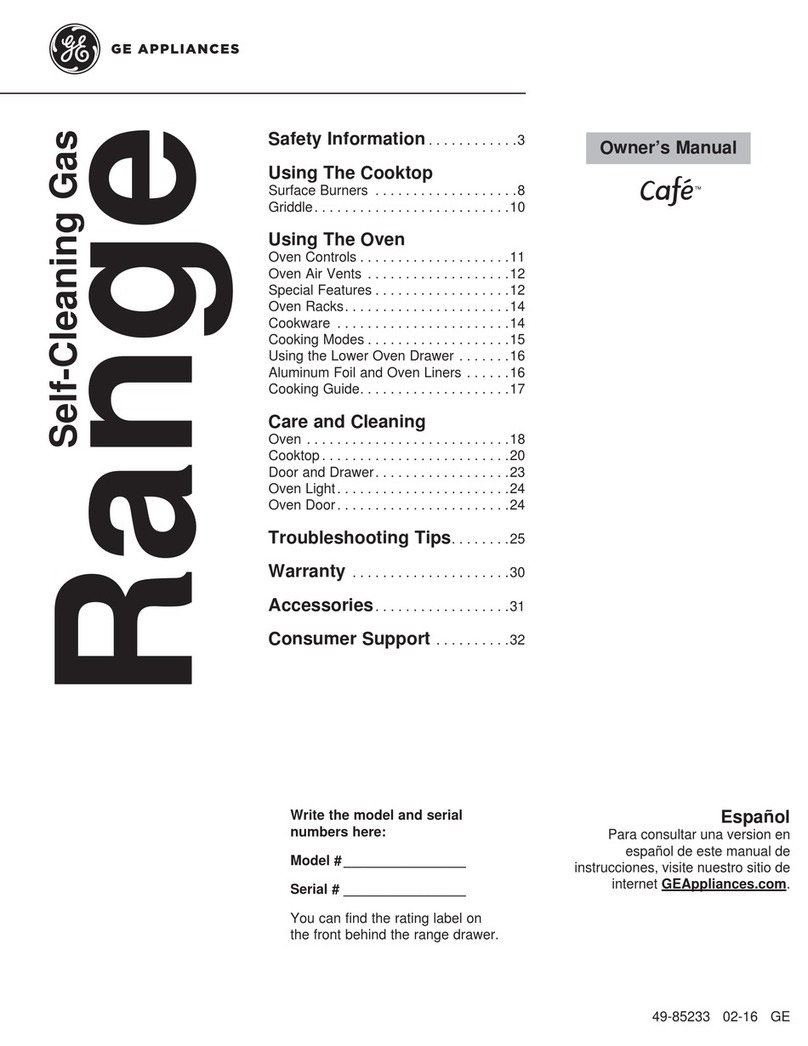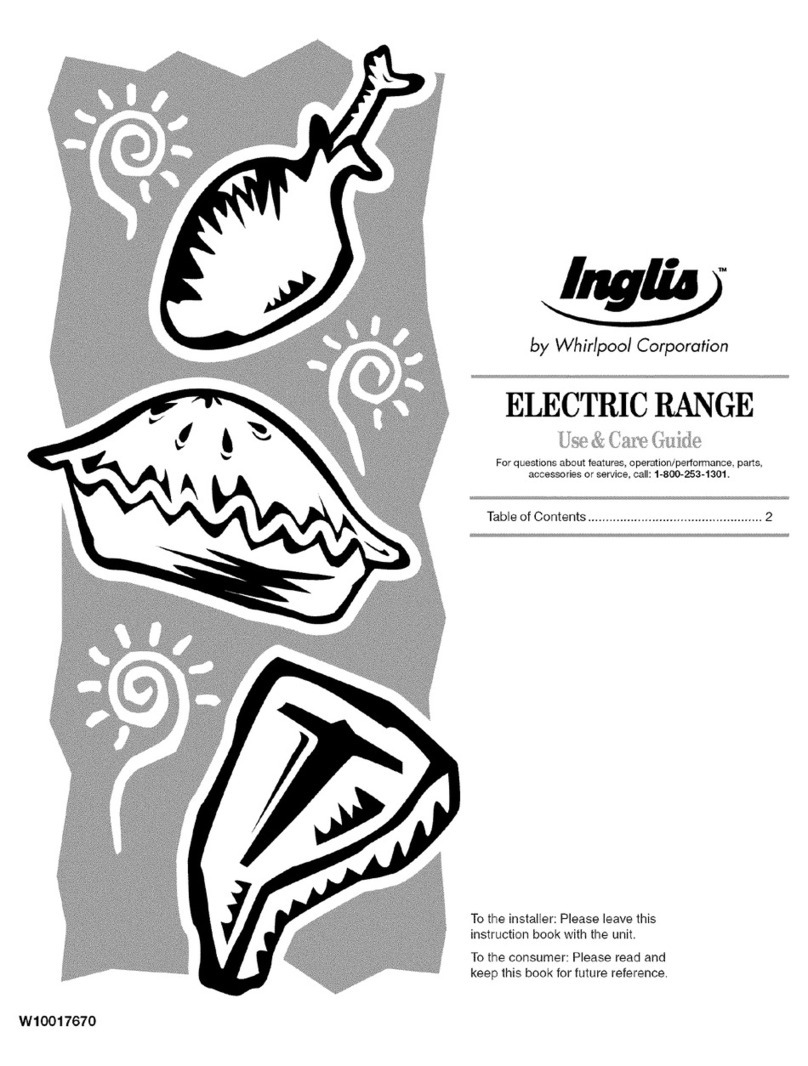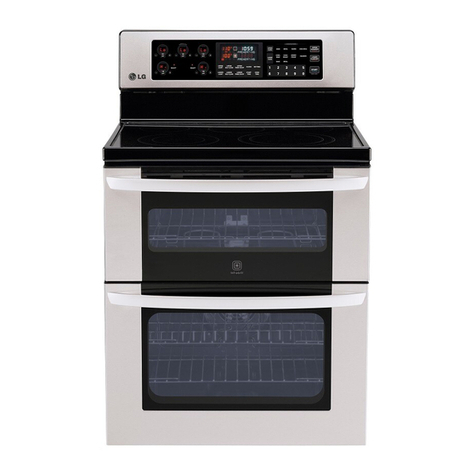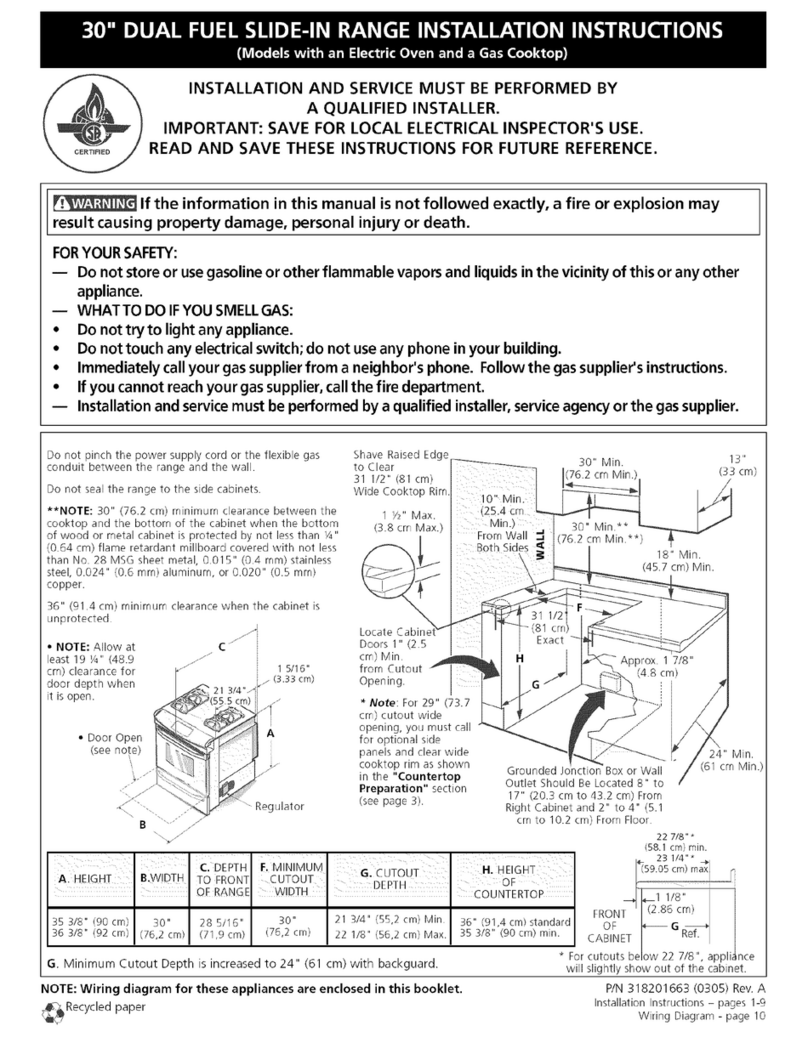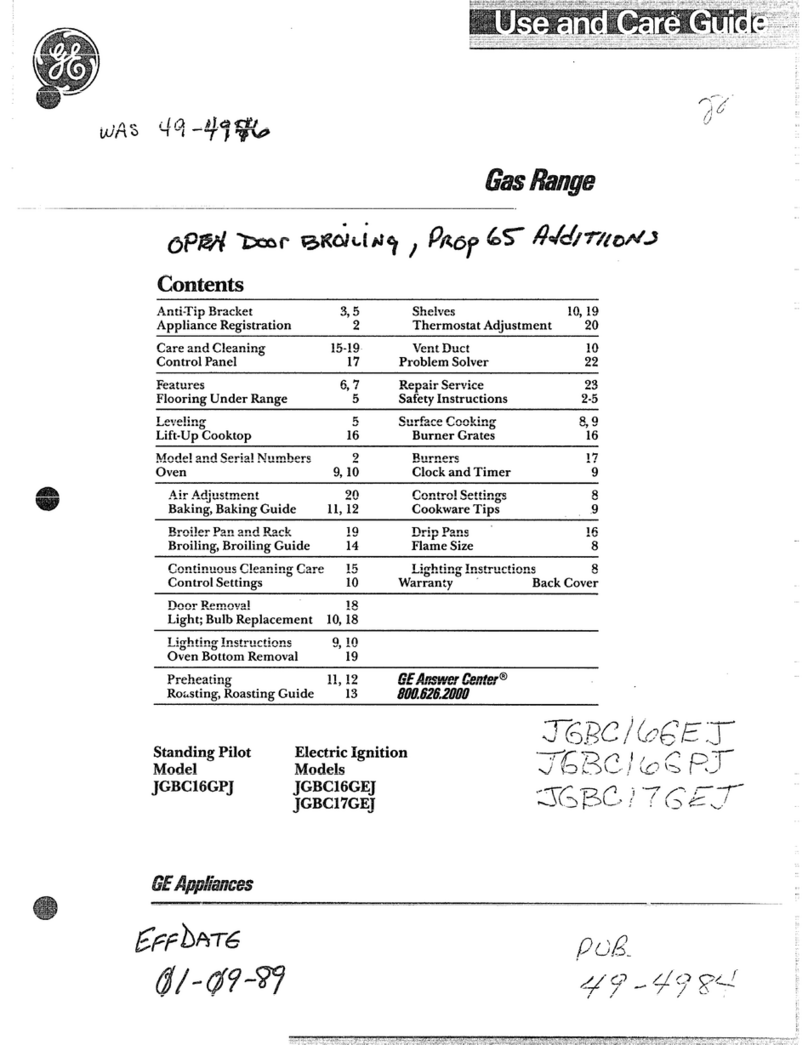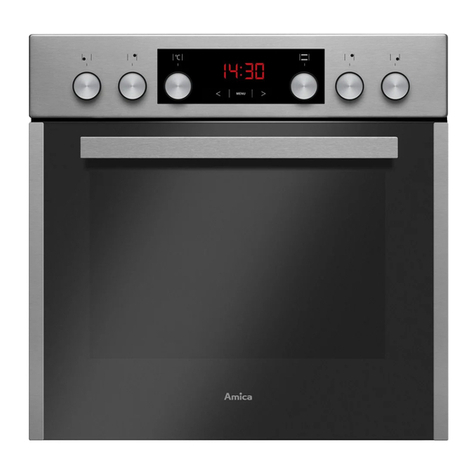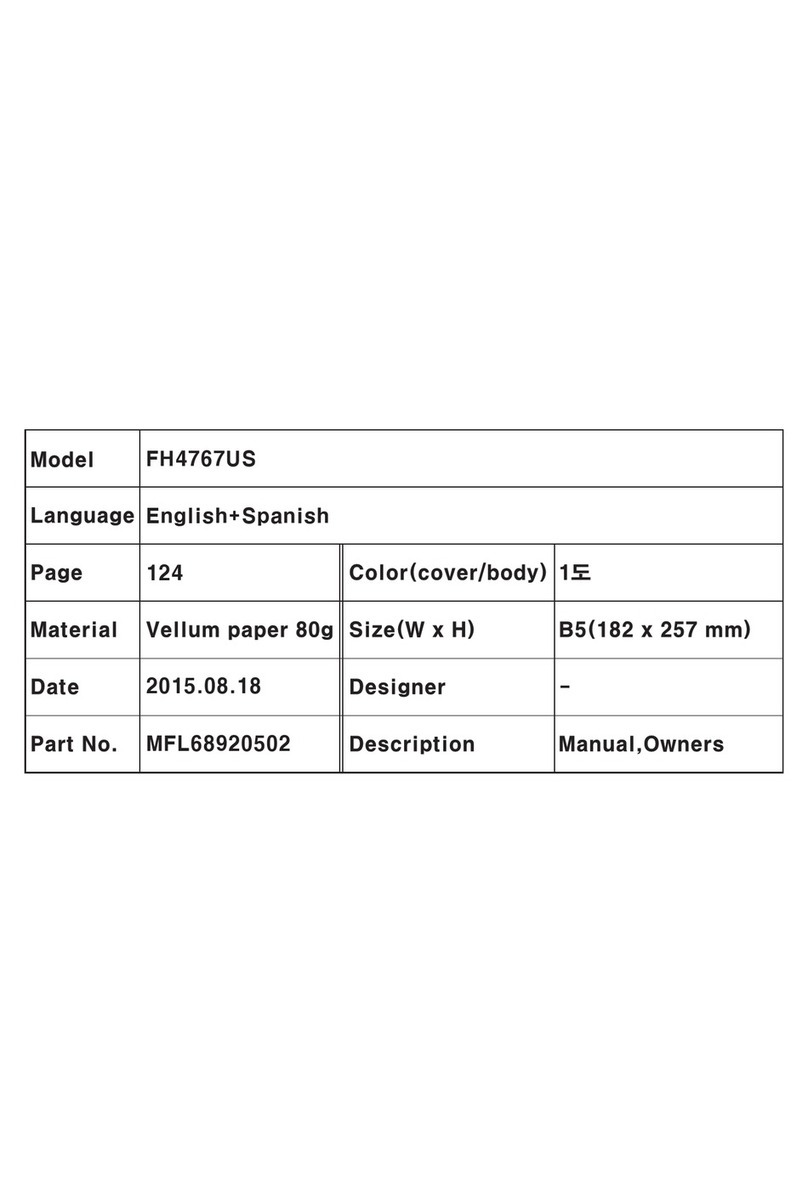Heartland Appliances U109760-02 User manual

Dual Fuel Range
Users Guide
&
Installation Instructions
U109760-02
Paragon

WARNING
If the information in this manual is not followed exactly, a fire or explosion
may result causing property damage, personal injury or death.
Do not
Do not
Do not
Do not
Immediately
If you cannot reach your gas supplier, call the fire department.
The anti-tip device supplied with this range must be correctly fitted when
the appliance is installed. This will reduce risk of tipping of the appliance
from abnormal usage or by excessive loading of the oven door
ALL RANGES CAN
TIP
INJURY TO PERSONS
COULD RESULT
INSTALL ANTI-TIP
BRACKET PACKED
WITH RANGE
SEE INSTALLATION
INSTRUCTIONS

General Safety Instructions Page 08
Cooktop Burners Page 10
The Ovens Page 12
The Left Hand Multi-function Oven Page 12
The Right Hand Convection Oven Page 12
The Clock Page 13
Both ovens Page 15
Multi-function oven Page 16
Deluxe Oven Tray Page 17
Oven racks Page 18
Oven light Page 18
Storage Page 19
Multi-function (Left hand) Oven cooking guide Page 20
Cooking chart Page 21
Cleaning your range Page 22
Troubleshooting Page 26
Service and spares Page 46
Installation Page 29

Important Safety Information
Have your appliance properly installed
and grounded by a qualified technician in
accordance with the National Electrical
Code ANSI/NFPA No. 70—latest edition, and
local code requirements. In Canada, electrical
grounding must be in accordance with the current
CSA C22.1 Canadian Electrical Code Part 1 and/
or local codes.
Install only as described in the installation
section of this book.
Ask your dealer to recommend a qualified
technician and an authorized repair service.
Know how to disconnect the power to the
range at the circuit breaker or fuse box in
case of an emergency.
The anti-tip device supplied with this range
must be correctly fitted when the appliance
is installed. This will reduce risk of tipping
of the appliance from abnormal usage or by
excessive loading of the oven door
ALL RANGES CAN TIP
INJURY TO PERSONS
COULD RESULT
INSTALL ANTI-TIP
BRACKET PACKED
WITH RANGE
SEE INSTALLATION
INSTRUCTIONS
Do not use water on grease fires. Never
pick up a flaming pan. Turn the controls off.
Smother a flaming pan on a cooktop burner
by covering the pan completely with a well
fitting lid or baking tray. If available use a
multipurpose dry chemical or foam-type fire
extinguisher.
If fire is in the oven or broiler pan, smother by
closing oven door. Open doors and windows
or if a hood is fitted turn it on to remove
smoke and odor.
Before using the range make sure all the
packing materials have been removed.
Always keep the area around the range free
from combustible materials, gasoline, and
other flammable vapors and liquids.
If the range is installed near a window, proper
precautions should be taken to prevent
curtains from blowing over the burners.
NEVER
Many plastics will burn and most are
damaged by heat. Keep plastic items away
from parts of the range that may become
warm or hot. Do not leave plastic items on the
cooktop as they may burn, melt or soften if
left too close to a vent or a lighted burner.
Storage should not be fitted directly above a
range. If anything is stored above the range,
it should be limited to infrequently used

Important Safety Information
items which can be safely stored in an area
subjected to heat from a range. Temperatures
may be unsafe for some items, such as
volatile liquids, cleaners or aerosol sprays.
Destroy the carton and plastic bags after
unpacking the range. Never allow children to
play with packaging material.
NEVER use this appliance as a space heater
to heat or warm the room. Doing so may
result in carbon monoxide poisoning and
overheating of the oven and control knobs.
Never cover any slots, holes or passages in
the oven bottom or cover an entire rack with
materials such as aluminum foil. Doing so
blocks air flow through the oven. Aluminum
foil linings may also trap heat causing a fire
hazard.
User servicing—Do not repair or replace
any part of the appliance unless specifically
recommended in this User Manual.
All other servicing should be done only by a
qualified technician, this may reduce the risk
of personal injury and damage to the range.
Never modify or alter the construction of a
range by removing leveling legs, panels, wire
covers, anti-tip brackets/screws, or any other
part of the product.
To avoid personal injury, do not sit, stand or
lean on oven or broiler doors or drawer.
Leaning, sitting or stepping on the doors or
drawer of this range can result in serious
injuries and also cause damage to the range.
Do not allow anyone to climb, stand or hang
on any part of the range.
Babies, toddlers and young children should
not be allowed near the range at any time.
They should never be allowed to sit or stand
on any part of the appliance.
Do not allow children to climb or play around
the range. The weight of a child on an open
door may cause the range to tip, resulting in
serious burns or other injury.
Teach them not to play with controls or any
other part of the range.
Never store items of interest to children in
the cabinets above a range or on backguard
of a range; children climbing on the range to
reach them could be seriously injured.
This instruction is based on safety
considerations
Flammable materials should not be stored in
an oven, the range storage drawer or near
the cooktop burners. This includes paper,
plastic and cloth items, such as cookbooks,
plasticware and towels, as well as flammable
liquids. Do not store explosives, such as
aerosol cans, on or near the appliance.
Flammable materials may explode and result
in fire or property damage.

Important Safety Information
To avoid risk of electrical shock, personal
injury, or death, make sure your range
has been properly grounded and always
disconnect it from main power supply before
servicing.
Do not
Gas burners may be hot even if they have
been off for some time. Areas near the gas
burners may become hot enough to cause
burns. During and after use, do not touch,
or let clothing touch or other flammable
materials contact the burners or areas near
the burners until they have had enough time
to cool. These areas include the rangetop
and backguard.
Oven and Broiler heating elements may be
hot though they are dark in color. Interior
surfaces of an oven or broiler may become
hot enough to cause burns. During and after
use, do not touch, or let clothing or other
flammable materials touch heating elements
or interior surfaces of oven until they have
had enough time to cool.
Other range surfaces that may become hot
enough to cause burns are the oven door
and oven vent at the base of the range
splashback.
Never wear loose-fitting or hanging clothes
while using the range. Be careful when
reaching for items stored in cabinets over the
cooktop. Flammable material could be ignited
if brought in contact with a burner flame or
hot surface and may cause severe burns.
Moist or damp potholders on hot surfaces
may result in burns from steam. Never let a
potholder touch hot heating elements.
Do not use a towel or other bulky cloth in
place of a glove. They might catch fire if they
touch a hot surface.
Use dry oven gloves when applicable - using
damp gloves might result in steam burns
when you touch a hot surface. Never operate
the range with wet hands.
The California Safe Drinking Water and Toxic
Enforcement Act of 1986 (Proposition 65)
requires the Governor of California to publish
a list of substances known to the State of
California to cause cancer or reproductive harm,
and requires businesses to warn customers of
potential exposures to such substances.
This appliance contains or produces a chemical
or chemicals which can cause death or serious
illness and which are known to the state of
California to cause cancer, birth defects or other
reproductive harm.
Users of this appliance are hereby warned
that the burning of gas can result in low-level
exposure to some of the listed substances,
including benzene, formaldehyde and soot, due
primarily to the incomplete combustion of natural
gas or liquid petroleum (LP) fuels. Properly
adjusted burners will minimize incomplete
combustion. Exposure to these substances
can also be minimized by properly venting the
burners to the outdoors.

Important Safety Information
To reduce the risk from substances in the fuel or
from fuel combustion make sure this appliance
is installed, operated, and maintained according
to the instructions in this booklet.
Important
Important
Be sure your appliance is properly installed
and grounded by a qualified technician.
Do not repair or replace any part of the
appliance unless specifically recommended
in the manual. All other servicing should be
referred to a qualified technician.
On Natural Gas the burners’ flames should be
a blueish color with, at most, a slight yellowish
fringe.
On Propane gas the flames may be “softer”.
The cooktop burner flames may have a slight
yellowish tip.
If the flame burns with a long white tip you
should call for service.
Normal flame appearance Burner not fitted correctly
MAKE SURE THE FLOW OF COMBUSTION
AND VENTILATION AIR TO THE RANGE IS
UNOBSTRUCTED.
This appliance is equipped with burners of
different sizes. Use utensils with flat bottoms.
Do not use unstable pans and position the
handles away from the edge of the cooktop.
Make sure the flames are under the pans. It’s
not safe to let the flames burn up the sides of
the pan; the handle may get too hot.
Proper relationship of utensil to burner will
also improve efficiency.
Never Leave
Protective Liners
Glazed Cooking Utensils
Utensil handles
When Opening Door
heat unopened food containers.
oven vent ducts unobstructed.

Important Safety Information
Always place oven racks in desired location
while oven is cool. If rack must be moved
while oven is hot, do not let potholder contact
hot heating element in oven.
Do not store items of interest to children in
cabinets above a range or on the backguard
of a range - children climbing on the range to
reach items could be seriously injured.
THIS APPLIANCE IS PROVIDED WITH
ROLLERS TO FACILITATE MOVEMENT
DURING INSTALLATION. THE RANGE
SHOULD NOT BE MOVED AFTER
INSTALLATION.
This appliance must be installed by a
competent person in accordance with the
installation instructions. The installation must
comply with the relevant regulations and
also the local electricity supply company
requirements
This appliance is designed for domestic
cooking only. Use for any other purpose could
invalidate any warranty or liability claim.
The use of a gas cooking appliance results
in the production of heat and moisture in
the room in which it is installed. Ensure that
the kitchen is well ventilated: keep natural
ventilation holes open or install a mechanical
ventilation device, (mechanical extractor
hood).
Prolonged intensive use of the appliance
may call for additional ventilation, for
example opening a window, or more effective
ventilation, for example increasing the level of
mechanical ventilation where present.
The range should be serviced by a qualified
service engineer and only approved spare
parts used. Have the installer show you the
location of the range control switch. Mark it
for easy reference. Always allow the range to
cool and then switch off at the mains before
cleaning or carrying out any maintenance
work, unless specified otherwise in this guide.
All parts of the range become hot with use
and will retain heat even after you have
stopped cooking.
Take care when touching range, to minimize
the possibility of burns, always be certain that
the controls are in the OFF position and that
it is cool before attempting to clean the range.
Clean with caution. If a wet sponge or cloth
is used to wipe spills on a hot surface, be
careful to avoid steam burns. Some cleansers
can produce noxious fumes if applied to a hot
surface.

Important Safety Information
Clean only parts listed in this guide.
In the interests of hygiene and safety the
range should be kept clean at all times as
a build up in fats and other food stuff could
result in a fire.
Always keep combustible wall coverings or
curtains etc. a safe distance away from your
range.
Do not spray aerosols in the vicinity of the
range while it is in use.
Do not store or use combustible materials,
or flammable liquids in the vicinity of this
appliance.
Take great care when heating fats and oils,
as they will ignite if they get too hot.
Use a deep fat thermometer whenever
possible to prevent overheating fat beyond
the smoking point.
Never leave a deep fry pan unattended.
Always heat fat slowly, and watch as it heats.
Deep fry pans should be only one third full
of fat. Filling the pan too full of fat can cause
spill over when food is added. If you use a
combination of oils or fats in frying, stir them
together before heating, or as the fats melt.
Foods for frying should be as dry as possible.
Frost on frozen foods or moisture on fresh
foods can cause hot fat to bubble up and over
the sides of the pan. Carefully watch for spills
or overheating of foods when frying at high or
medium high temperatures. Never try to move
a pan of hot fat, especially a deep fry pan.
Wait until the fat is cool.
When using an electrical appliance near
the cooktop, be sure that the cord of the
appliance does not come into contact with
the cooktop.
Take care that no water seeps into the
appliance
Make sure that your kitchen is well ventilated
at all times. Use extractor fans or hoods when
fitted.
The range is designed for cooking foods only
and must not be used for any other purpose.
The oven should NOT be used for heating the
kitchen, not only does this waste fuel but the
control knobs may become overheated.
When the oven is on DO NOT leave the oven
door open for longer than necessary.
The specification of this range should not be
altered.
This appliance is heavy, take care when
moving it.
When the range is not in use ensure that the
control knobs are in the off position.

The drawing by each knob indicates which burner that
knob controls. Each burner has a special safety device that
stops the flow of gas if the flame goes out.
Push in and turn a knob to the ( ) lighting position.
Keep holding the knob pressed in to let the gas through
to the burner for few seconds. The igniter should spark
and light the gas.
If, when you let go of the control knob, the burner goes
out, the safety device has not held in. Turn the control
to the off position and wait one minute, then try again
this time holding in the control knob for slightly longer.
Adjust the flame height to suit by turning the knob. On
this range the low position is beyond high, between
high and off. The ‘LO’ marks the low position. Turn the knob
towards it after the contents of a pan have boiled.
Make sure flames are under the pans. For safety reasons,
adjust the flames so that they do not extend beyond the
edge of the cooking utensil. This instruction is based on
safety considerations.
Pans and kettles with concave bases or down turned base
rims should not be used.
Simmering aids, such as asbestos or mesh mats,
are NOT recommended. They will reduce burner
performance and could damage the grates.
Avoid using unstable and misshapen pans that may
tilt easily and pans with a very small base diameter
e.g. milk pans, single egg poachers. The minimum pan
diameter recommended is 43/4”.
The Wok burners are designed to provide even heat
over a large area. They are ideal for large pans and
stir frying. When using large pans ensure that the
pan does not over hang the edge of the cooktop. For
heating smaller pans the smaller burners may be more
efficient.
If, after lighting, a cooktop burner’s flame goes out, turn it
off and leave it for one minute before relighting it.

If there is a power failure, the cooktop burners
can be lit with a match.
1. Hold a burning a match ½ inch from the
burner head keeping your hand as far
horizontally away from the burner as possible.
2. Push and turn burner control knob to HI/
lighting position. As soon as the burner flame
lights move your hand away. With your other
hand, keep holding the knob pressed for a
few seconds so that the burner safety device
can ‘sense’ the heat of the flame.
3. Turn burner control knob to OFF position when
finished.
You should wipe the enamel top surface of the
range around the cooktop burners as soon as
possible after spills occur.
Use of aluminum pans may cause metallic marking
of the grates. This does not affect the durability of
the enamel and may be cleaned off with a metal
polish.

The clock must be set to the time of day before the ovens will work. See ‘The Clock’ section for
instructions on setting the time of day.
The left hand oven is a Multi-function oven. As well
as the oven fan and fan element, it is fitted with
two extra heating elements, one visible in the top
of the oven and the second under the oven base.
Take care to avoid touching the top element and
element deflector when placing or removing items
from the oven. For more detail on this oven see
the section ‘Multi-function oven’.
The fan in the right hand oven circulates hot air
continuously, which means faster more even
cooking.
The recommended cooking temperatures for a
fanned oven are generally lower than a non-fanned
oven.
function temperature
The Multi-function oven has two controls, a
function selector and a temperature setting knob.
The right hand fan oven control is at the right hand
end of the control panel.
Turn the function selector control to a cooking
function. This is the fan oven setting.
Turn the oven temperature knob to the
temperature you need.
Turn the oven temperature knob to the
temperature you need.
The oven heating light will glow until the oven has
reached the temperature you selected. It will then
cycle on and off during cooking.
The oven heating light will glow until the oven has
reached the temperature you selected. It will then
cycle on and off during cooking.

Setting knob Adjusting knob
When the clock is first connected the display will
flash ( ) and ( ) alternately.
To set the clock to read
the time of day turn and
hold the Setting knob to
the clock symbol ( )
and at the same time
turn the Adjusting knob
left or right until the
clock shows the time of
day. .
Let go of the Setting knob and it will spring back
to the vertical ( ) oven manual setting.
If the key symbol ( ) appears on the left of the
display you have accidentally turned on the
key lock feature. See the section ‘Clock Special
Features’.
Turn the Setting knob
to the right to the ( )
minute minder setting
- it should click into
position.
Use the adjustment
knob to set the time
you need.
You can turn the knob
back to the ( ) manual
setting to keep an eye
on the time of day
or leave it in the ( )
minute minder position
as the time ticks down.
Turn the Adjusting knob counter clockwise
Use when you have started the oven manually.
Turn the Setting knob to
the ( ) position.
Use the adjustment
knob to set the time you
need.
‘Stop Time’ shows.
AUTO will show in the
display.
Turn the Setting knob to the (auto) setting.
When your cooking is finished the beeper
sounds. Turn the Setting knob to the vertical ( )
to return to manual cooking.
Before you set the clock, you must have two
numbers clearly in mind.
The ‘cook time’, which is the period of time you
want the oven to cook. The maximum cooking
time is 11 hours 59 minutes.
The ‘stop time’, which is the time of day you
want the oven to stop cooking. This must be less
than 12 hours from the current time.
You cannot set a start time directly - this is set
automatically by setting the cooking period and
stop time.
Turn the Setting knob to
the ( ) position.
Use the Adjusting knob
to set the ‘cooking time’
you need.

Turn the Setting knob to
the ( ) position.
The display will show
the current time of day
plus the ‘cook period’
you just set.
Use the adjustment
knob to set the ‘Stop
time’ you need.
‘Stop Time’ shows.
AUTO will show in the
display.
Set the oven(s) to the cooking temperature you
need (don’t forget to set a function if using the
Multi-function oven).
Turn the Setting knob to
the (auto) setting.
The clock shows the
time of day and ‘AUTO’.
When your cooking is finished the beeper
sounds. Turn the Setting knob to the vertical ( )
to return to manual cooking.
If you are out, don’t worry about the beeper
going off, it stops after a while. When you return,
turn the Setting knob to the vertical ( ) to return
to manual cooking. Turn the thermostat to the off
position.
You can cancel any automatic settings by briefly
turning the Setting knob to the manual symbol
( ).
When the key lock is activated, the clock can
be operated as usual but the ovens are locked
and will not come on. This means that your child
could select a cook program but the program will
not be activated and ovens will not switch on.
Turn and hold the
Setting knob to the clock
symbol ( ) for about 8
seconds.
‘On’ will appear on the
display.
Keep holding the
Setting knob turned to
the clock symbol ( )
and turn the Adjusting
knob clockwise until the
key symbol ( ) and ‘Of’
shows on the display.
Let go of the knobs.
The ovens are now
locked. After a few
seconds the display
will revert to show the
time of day and the key
symbol.
Turn and hold the
Setting knob to the clock
symbol ( ) for about 8
seconds. ‘Of’ will appear
on the display.
Keep holding the Setting
knob turned to the
clock symbol ( ) and
turn the Adjusting knob
clockwise until the key
symbol ( ) goes out on
the display. Let go of the
knobs.
After a few seconds
the display will revert to
show the time of day.
The ovens can now be used normally.

The timer can be used to turn just one oven
or both on and off automatically. The start and
stop time must be the same for both ovens but
different cooking temperatures can be set.
If you want to turn one of the ovens on
at the same time as the timer is set for
automatic cooking, you must wait until
the timer has turned on the oven/ ovens
first. Then you can adjust either of them
manually in the normal way.
You can set the oven for a combined delay and
cook cycle of up to 11 hours 59 minutes.
If you want to cook more than one dish,
choose dishes that require approximately
the same time. However, dishes can be
‘slowed down’ slightly by using small
containers and covering them with
aluminum foil, or ‘speeded up’ slightly by
cooking smaller quantities or placing in
larger containers.
Never allow aluminum foil to
contact the heating elements.
Very perishable foods such as pork, dairy
products or seafood should be avoided if a
long delay period is planned, especially in hot
weather.
Don’t place warm food in the oven.
Don’t use an oven already warm.
Don’t use if an adjoining oven is warm.
Avoid using wine or beer if there is a delay
period, as fermentation may take place.
To avoid curdling, cream should be added to
dishes just before serving.
Fresh vegetables, which may discolor during a
delay period, should be coated in melted fat or
immersed in a water and lemon juice solution.
Fruit pies, custard tarts or similar wet mixtures
on top of uncooked pastry are only satisfactory if
there is a short delay period. Dishes containing
leftover cooked meat or poultry should not be
cooked automatically if there is a delay period.
Whole poultry must be thoroughly defrosted
before placing in the oven.
Check that meat and poultry are fully
cooked before serving.
Automatic cooking is not recommended for
baked items that require a pre-heated oven such
as cakes, cookies and breads.
Before using for the first time, heat the ovens
to 400°F for 30 minutes to expel manufacturing
odors.
The wire racks should always be pushed firmly
to the back of the oven.
Bakeware, meat pans etcetera should be placed
level centrally on the oven’s wire racks. Keep all
trays and containers away from the sides of the
oven, as overbrowning of the food may occur.
For even browning, the maximum recommended
size for a baking sheet is 141/4” wide by 12”
deep.
Always place baking sheets with the widest part
across the oven.
Cooking high moisture
content foods can create
a ‘steam burst’, when the
oven door is opened. When
opening the oven stand well
back and allow any steam to
disperse.
When the oven is on, don’t
leave the door open for longer
than necessary, otherwise the knobs may get
very hot.
• Always leave a ‘fingers width’ between dishes
on the same rack. This allows the heat to
circulate freely around them.
• Cover meat when cooking to avoid fat
splashes.
• To reduce fat splashing when you add
vegetables to hot fat around a roast, dry them
thoroughly or brush lightly with cooking oil.
• Sufficient heat rises out of the oven while
cooking to warm plates in the broiler
compartment.
• If you want to brown the base of a pastry
dish, preheat the baking sheet for 15 minutes
before placing the dish in the center of the
sheet or use the base heat in the Multifunction
oven.
• Where dishes may boil and spill over during
cooking, place them on a baking sheet.

The left hand oven of your range is Multi-
function. It has many varied uses. We suggest
you keep a careful eye on your cooking until you
are familiar with each function. Remember - not
all functions will be suitable for all food types.
Please remember that all ranges vary -
temperatures in your new ovens may differ to
those in your previous range.
This function operates the fan to circulate cold
air only. No heat is applied. This enables small
items such as desserts, cream cakes and pieces
of meat, fish and poultry to be defrosted.
Defrosting in this way speeds up the process
and protects the food from flies. Pieces of meat,
fish and poultry should be placed on a rack, over
a tray to catch any drips. Be sure to wash the
rack and tray after defrosting.
Defrost with the oven door closed.
Large items, such as whole chickens and meat
roasts should be defrosted in this way. We
recommend this be carried out in a refrigerator.
Defrosting should not be carried out in a warm
oven or when an adjoining oven is in use or still
warm.
Ensure that dairy foods, meat and poultry are
completely defrosted before cooking.
This function operates the fan and the heating
element around it. An even heat is produced
throughout the oven, allowing you to cook large
amounts quickly.
Fan oven cooking is particularly suitable for
multi-rack cooking and is a good ‘all-round’
function. It may be necessary to reduce the
temperature by approximately 20°F for recipes
previously cooked in a conventional oven.
If you wish to pre-heat the oven, wait until the
indicator light has gone out before inserting the
food.
This function operates the fan whilst the top
element is on. It produces a more even, less
fierce heat than a conventional broiler. For best
results, place the food to be grilled, on the grid
in the deluxe oven tray. Thick pieces of meat
or fish are ideal for cooking in this way, as the
circulated air reduces the fierceness of the heat
from the broiler. The oven door should be kept
closed whilst cooking is in progress, so saving
energy. You will also find that the food needs
to be watched and turned less than for normal
broiling. Pre-heat this function before cooking.
This function operates the fan, circulating air
heated by the elements at the top and the
base of the oven. The combination of fan and
conventional cooking (top and base heat) makes
this function ideal for cooking large items that
need thorough cooking, such as a large meat
roast. It is also possible to bake on two racks at
one time, although they will need to be swapped
over during the cooking time, as the heat at the
top of the oven is greater than at the base, when
using this function.
This is a fast intensive form of cooking; keep an
eye on the food cooking until you have become
accustomed to this function.

This function combines the heat from the top
and base elements. It is particularly suitable for
roasting and baking pastry, cakes and biscuits.
Food cooked on the top rack will brown and
crisp faster than on the lower rack, because the
heat is greater at the top of the oven than at the
base, as in ‘Convection assisted oven’ function.
Similar items being cooked will need to be
swapped around for even cooking. This means
that foods requiring different temperatures can
be cooked together, using the cooler zone in the
lower half of the oven and hotter area to the top.
This function uses the element in the top of the
oven only. It is a useful function for the browning
or finishing of pasta dishes, vegetables in sauce
and lasagne, the item to be browned being
already hot before switching to the top element.
This function uses the base element only. It will
crisp up your pizza or quiche base or finish off
cooking the base of a pastry case on a lower
rack. It is also a gentle heat, good for slow
cooking of casseroles in the middle of the oven
or for plate warming.
The Browning and Base heat functions are
useful additions to your oven, giving you
flexibility to finish off items to perfection. With
use, you will soon realize how these functions
can combine to extend your cooking skills.
The Right Hand Oven
The fan in the right hand oven circulates hot air
continuously, which means faster more even cooking.
The recommended cooking temperatures for a fanned
oven are generally lower than a non-fanned oven.
The right hand fan oven control is at the right hand end of
the control panel.
Turn the oven temperature knob to the temperature you
need.
The oven indicator light will glow until the oven has
reached the temperature you selected. It will then cycle on
and off during cooking.
Both Ovens
Before using for the first time, heat the ovens to 200°C for
30 minutes to dispel manufacturing odours.
Please remember that all cookers vary - temperatures
in your new ovens may differ to those in your previous
cooker.
The shelves should always be pushed firmly to the back of
the oven.
Baking trays meat tins etcetera should be placed level
centrally on the oven’s wire shelves. Keep all trays
and containers away from the sides of the oven, as
overbrowning of the food may occur.
Cooking high moisture content foods can create a ‘steam
burst’, when the oven door is opened. When opening the
oven stand well back and allow any steam to disperse.
When the oven is on, don’t leave the door open for longer
than necessary, otherwise the knobs may get very hot.
• Always leave a ‘fingers width’ between dishes on the same
shelf. This allows the heat to circulate freely around them.
• Cover meat when cooking.
• To reduce fat splashing when you add vegetables to hot fat
around a roast, dry them thoroughly or brush lightly with
cooking oil.
• If you want to brown the base of a pastry dish, preheat the
baking tray for 15 minutes before placing the dish in the
centre of the tray.
• Where dishes may boil and spill over during cooking, place
them on a baking tray.
Oven shelves
Each oven is supplied with three different shelves.
A deluxe oven tray.
The deluxe oven tray in the left hand multifunction oven is
supplied with a support grid or trivet so that it can be used
for grilling as well as normal oven cooking.

The rack guard should be at the back pointing upwards
As well as the flat racks some models are
supplied with drop racks The drop racks
increases the possibilities for oven rack spacing.
Flat rack
Drop rack
The oven racks can be easily removed and
refitted.
Pull the rack forward
until the back of the
rack is stopped by the
rack stop bumps in the
oven sides.
Lift up the front of the
rack so the back of the
rack will pass under
the rack stop and then
pull the rack forward.
To refit the rack, line up the rack with a groove
in the oven side and push the rack back until
the ends hit the rack stop. Lift up the front so the
rack ends clear the rack stops, and then lower
the front so that the rack is level and push it fully
back.
When cooking foods with high water content
(e.g. oven fries) there may be some steam
visible at the grille at the rear of the cooktop.
This is perfectly normal.
Press the appropriate button to turn on one of
the oven lights.
If one of the oven lights fail,
before you change the bulb. See the
‘Troubleshooting’ section for details on how to
change an oven light bulb.

The bottom drawer is for storing oven trays and
other cooking utensils.
It can get very warm, don’t store anything in
it which may melt or catch fire. Never store
flammable materials in the drawer. This
includes paper, plastic and cloth items, such as
cookbooks, plasticware and towels, as well as
flammable liquids. Do not store explosives, such
as aerosol cans, on or near the appliance.
Flammable materials may explode and result
in fire or property damage.
The drawer can be removed completely for
cleaning etc.
Lift up the ends of the plastic clips (one each
side) to release the catches holding the drawer
to the side runners and at the same time pull the
drawer forward and away from the side runners.
For safety’s sake push the drawer runners back
out of the way.
Pull out the side runners. Rest the drawer back
on the side runners and, keeping it level, push
it right back. The clips should click into position
holding the drawer to the side runners.

Remember - not all modes will be suitable for all food types. The oven control settings and
cooking times given are intended to be used only as a guide. Individual tastes may require the
temperature to be altered to provide a preferred result.
Food is cooked at a lower temperature in a convection oven than in a conventional oven. When using
recipes, reduce the temperature by 20°F and the cooking time by 5-10 minutes. The temperature in
the convection oven is the same throughout, ensuring uniform results.
The racks should not be fitted directly one above the other. When cooking on more than one
rack always leave at least one runner space between them. Place baking sheets, individual
cake tins or baking dishes centrally on the oven rack. For best results pre-heat the oven until
the oven indicator light goes out.
Food Temp
Oven Rack
Position Approximate Cooking Time
Cup cake 340°F 2-4 20 min
Scone (British) 350°F 2-4 15 min
Deep apple pie 350°F 2-4 45 min interchange after 25 minutes according to size.
Plate tart 375°F 2-4 45 min interchange After 25 minutes according to size.
Fruit cake 8” x 3 1/2” 225°F 3 1 hr 45 min - 2 hr
Puff pastry 425°F 3 - 5 15-40 mins according to size. Interchange 2/3rds through cooking time
Angel food cake 325°F 3 50 - 60 minutes
Brownies 350°F 2-4 25 - 30 min interchange after 15 minutes
Muffins 350°F 2-4 25 - 25 min interchange after 15 minutes
Cookies 350°F 2-4 10 - 15 min interchange after 8 minutes
Pound cake 350°F 3 40 - 60 minutes
For roast meats and poultry refer to the Convection oven guide - reduce cooking time slightly.
This manual suits for next models
1
Table of contents
Other Heartland Appliances Range manuals
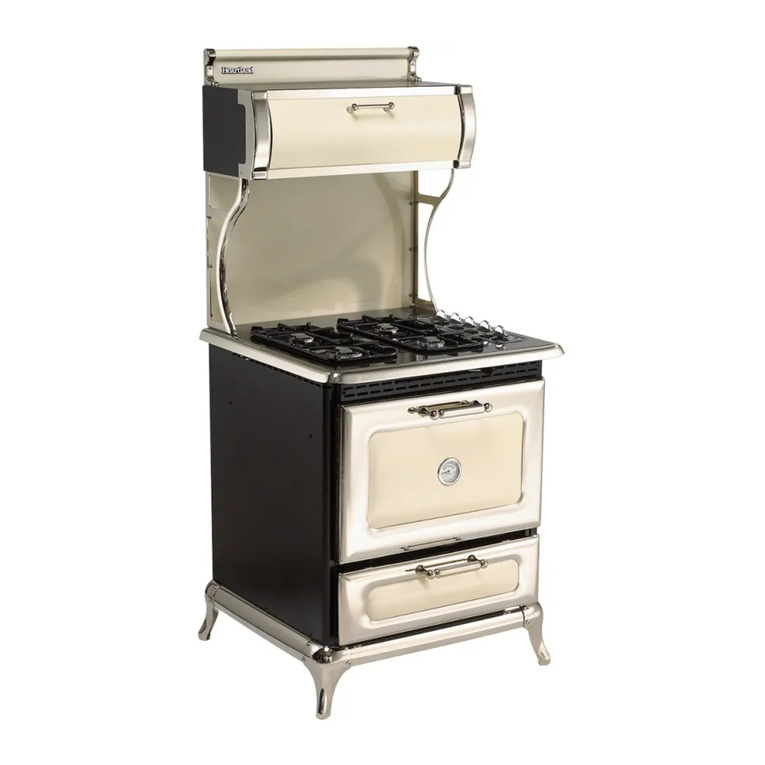
Heartland Appliances
Heartland Appliances 4200 User manual
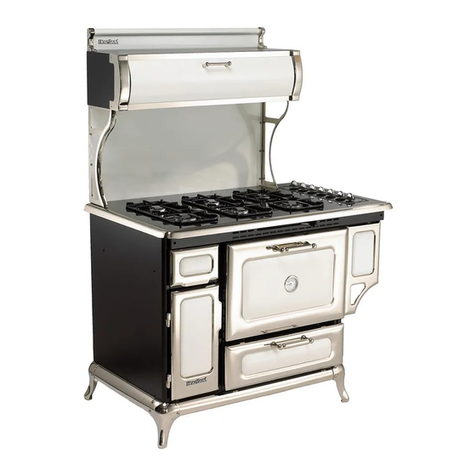
Heartland Appliances
Heartland Appliances 5200 User manual

Heartland Appliances
Heartland Appliances 3825 User manual

Heartland Appliances
Heartland Appliances Legacy 3630 User manual
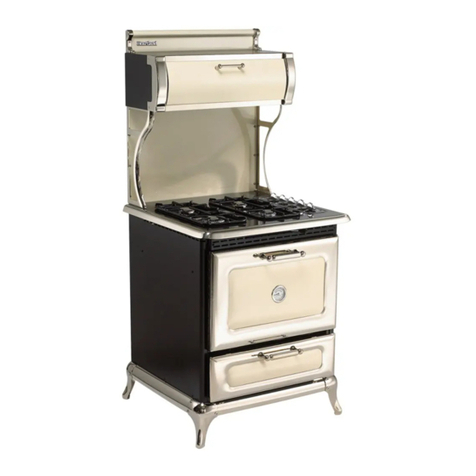
Heartland Appliances
Heartland Appliances 9100 User manual

Heartland Appliances
Heartland Appliances Metro User manual

Heartland Appliances
Heartland Appliances Legacy 3530 User manual
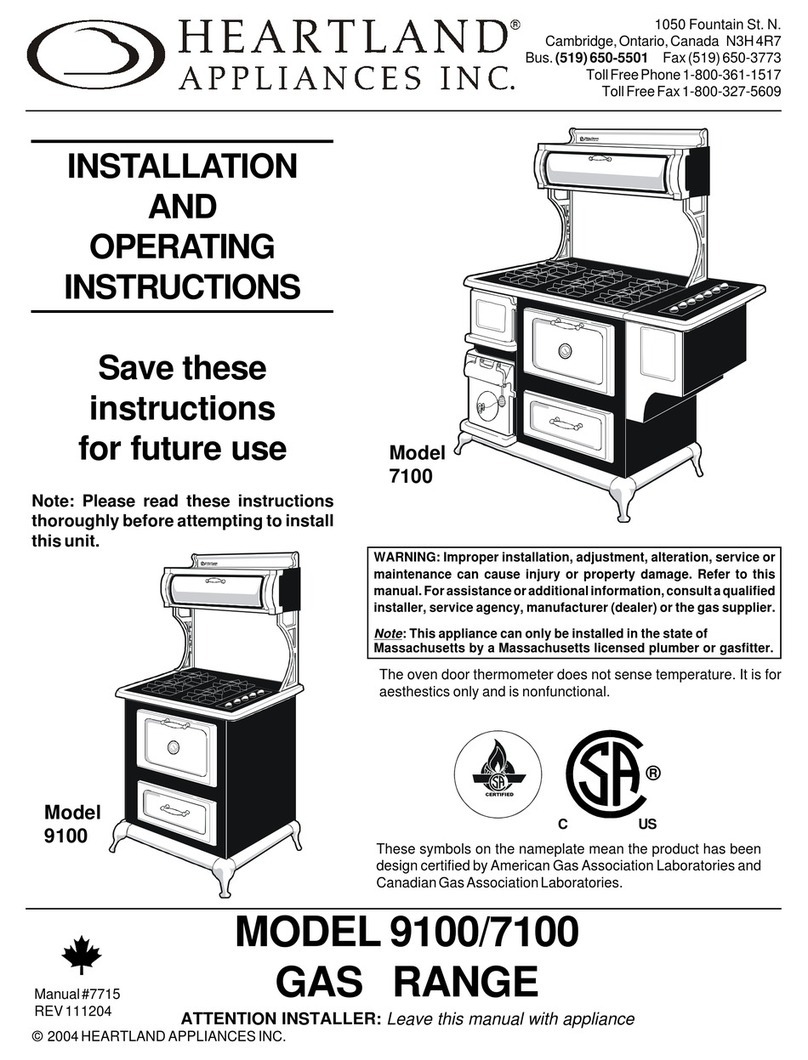
Heartland Appliances
Heartland Appliances 7100 User manual
